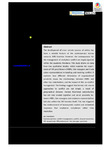Disconnected human resource? Proximity and the (mis)management of workplace conflict
| dc.contributor.author | Saundry, R | |
| dc.contributor.author | Fisher, V | |
| dc.contributor.author | Kinsey, Sue | |
| dc.date.accessioned | 2020-09-15T08:01:57Z | |
| dc.date.available | 2020-09-15T08:01:57Z | |
| dc.date.issued | 2020-08-19 | |
| dc.identifier.issn | 0954-5395 | |
| dc.identifier.issn | 1748-8583 | |
| dc.identifier.other | 12318 | |
| dc.identifier.uri | http://hdl.handle.net/10026.1/16262 | |
| dc.description.abstract |
<jats:title>Abstract</jats:title><jats:p>The development of more remote sources of advice has been a notable feature of the contemporary human resource (HR) function. However, the consequences for the management of workplace conflict are largely ignored within the academic literature. This study draws on data from two qualitative studies, which examine the experiences of HR practitioners (HRPs), line managers and trade union representatives in handling and resolving conflict. It explores how different dimensions of organisational proximity shape the relationships between HRPs and other key stakeholders, and the impact of this on conflict management. The findings suggest that formal, risk averse approaches to conflict are not simply a result of geographical distance. Instead, functional specialisation has not only eroded cognitive and social proximity between HRPs, line managers and employee representatives but also within the HR function itself. This has triggered the reinforcement of bureaucratic control and embedded responses that emphasise compliance rather than resolution.</jats:p> | |
| dc.format.extent | 476-492 | |
| dc.language | en | |
| dc.language.iso | en | |
| dc.publisher | Wiley | |
| dc.subject | business partner | |
| dc.subject | conflict management | |
| dc.subject | conflict | |
| dc.subject | dispute resolution | |
| dc.subject | HR department | |
| dc.subject | HR professional | |
| dc.subject | line manager | |
| dc.subject | proximity | |
| dc.title | Disconnected human resource? Proximity and the (mis)management of workplace conflict | |
| dc.type | journal-article | |
| dc.type | Journal Article | |
| plymouth.author-url | https://www.webofscience.com/api/gateway?GWVersion=2&SrcApp=PARTNER_APP&SrcAuth=LinksAMR&KeyUT=WOS:000560530200001&DestLinkType=FullRecord&DestApp=ALL_WOS&UsrCustomerID=11bb513d99f797142bcfeffcc58ea008 | |
| plymouth.issue | 2 | |
| plymouth.volume | 0 | |
| plymouth.publication-status | Published | |
| plymouth.journal | Human Resource Management Journal | |
| dc.identifier.doi | 10.1111/1748-8583.12318 | |
| plymouth.organisational-group | /Plymouth | |
| plymouth.organisational-group | /Plymouth/Faculty of Arts, Humanities and Business | |
| plymouth.organisational-group | /Plymouth/REF 2021 Researchers by UoA | |
| plymouth.organisational-group | /Plymouth/REF 2021 Researchers by UoA/UoA17 Business and Management Studies | |
| plymouth.organisational-group | /Plymouth/Users by role | |
| dcterms.dateAccepted | 2020-07-27 | |
| dc.rights.embargodate | 2020-9-18 | |
| dc.identifier.eissn | 1748-8583 | |
| dc.rights.embargoperiod | Not known | |
| rioxxterms.versionofrecord | 10.1111/1748-8583.12318 | |
| rioxxterms.licenseref.uri | http://www.rioxx.net/licenses/all-rights-reserved | |
| rioxxterms.licenseref.startdate | 2020-08-19 | |
| rioxxterms.type | Journal Article/Review |


